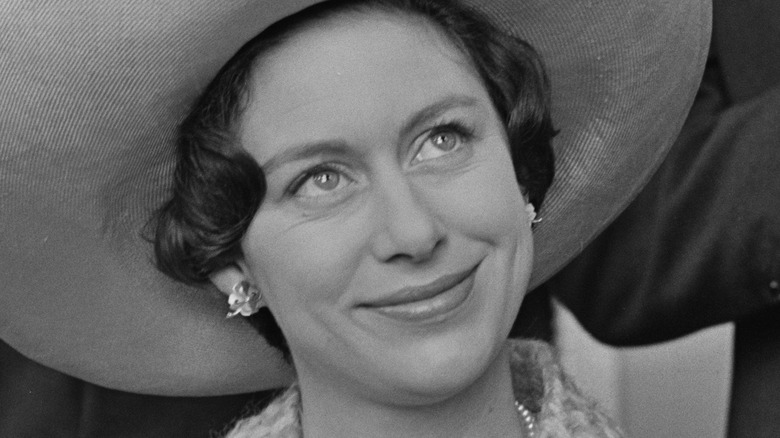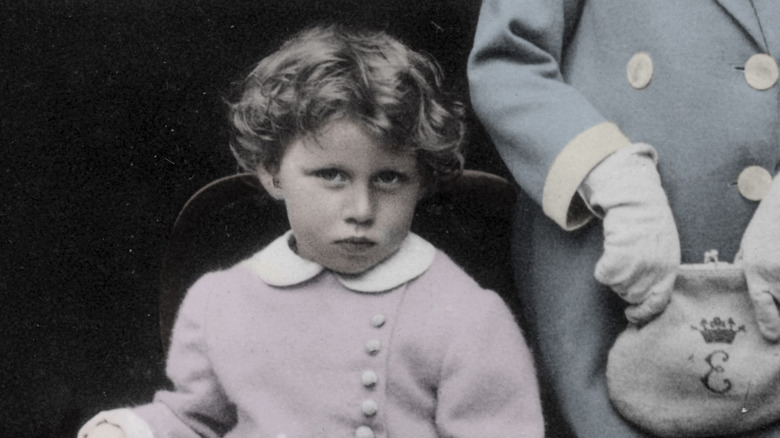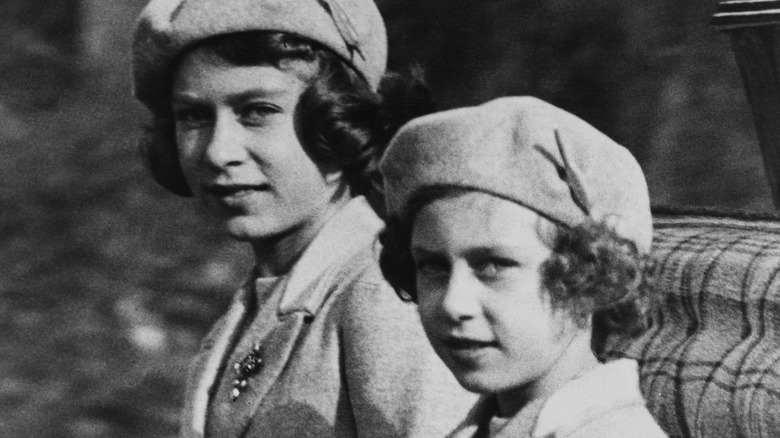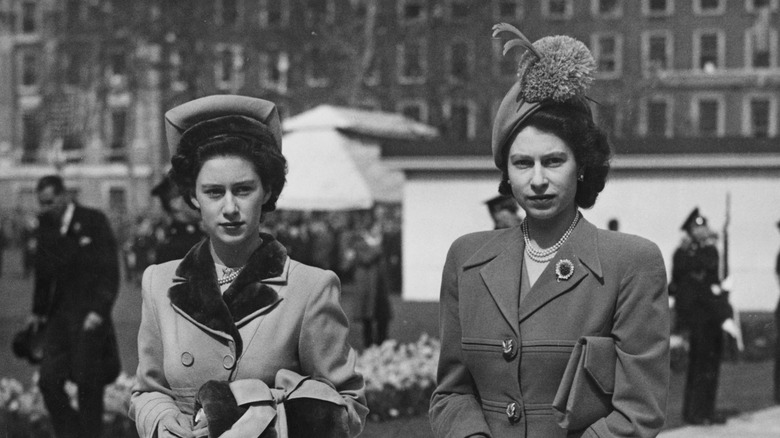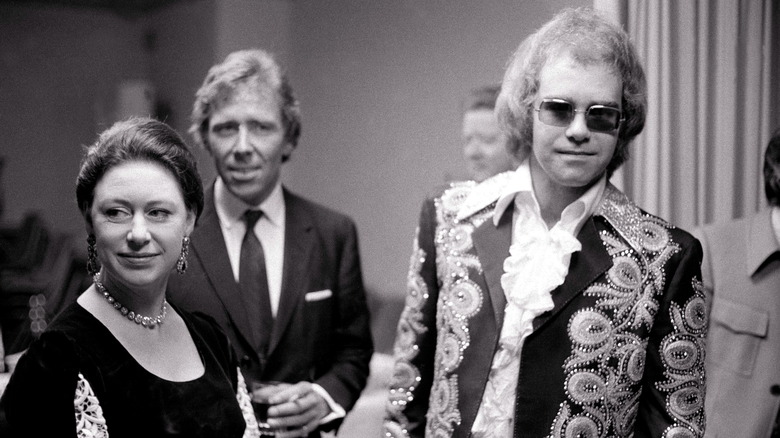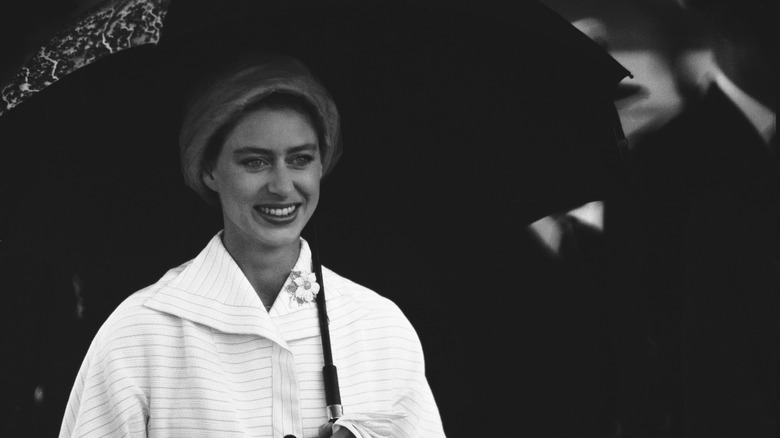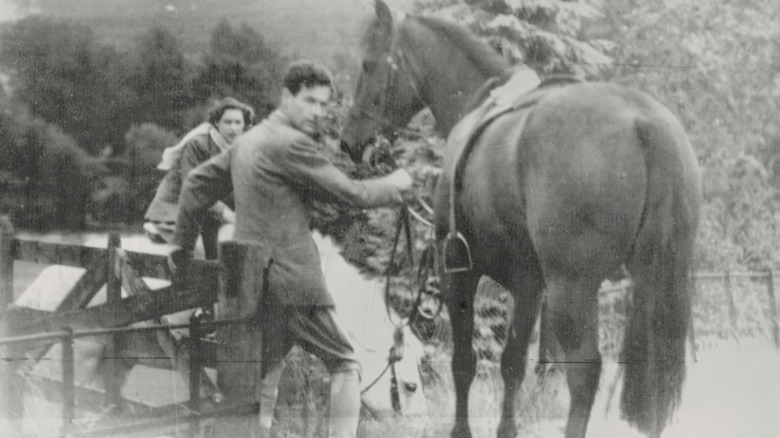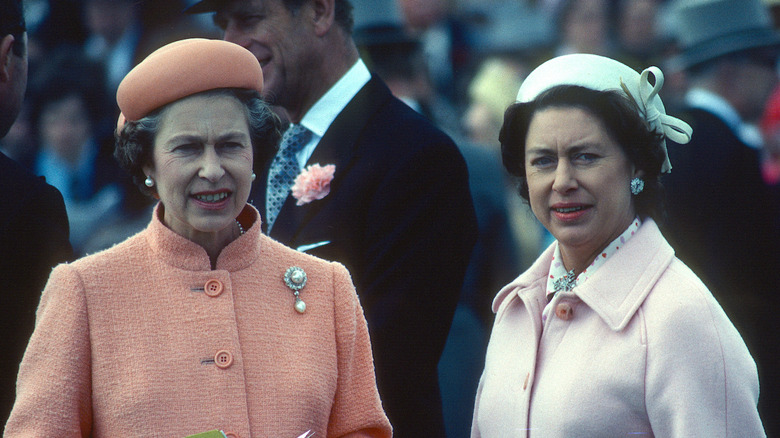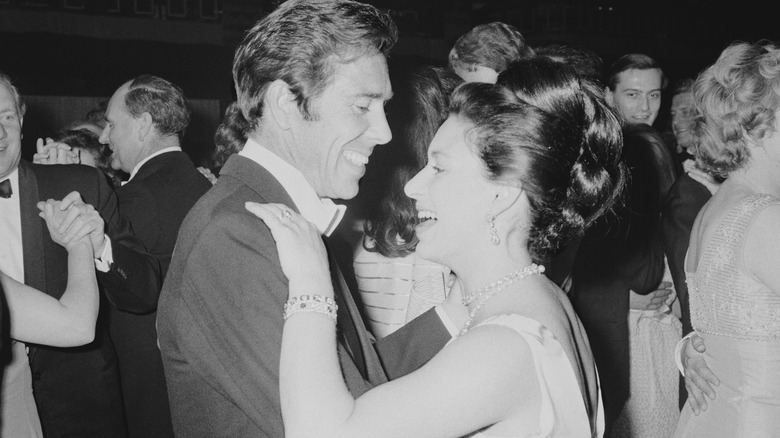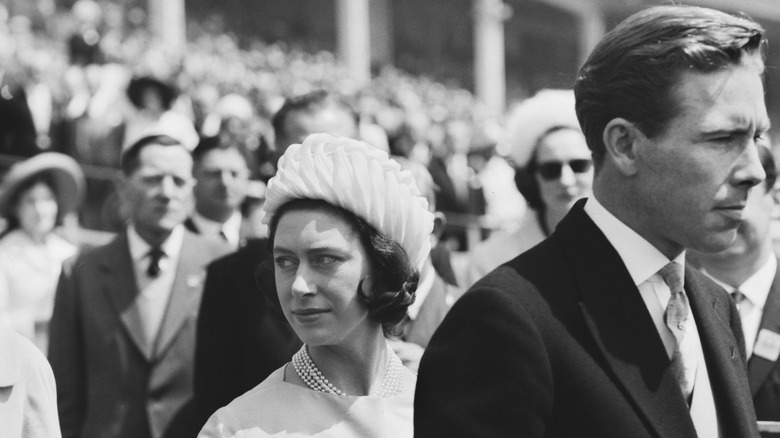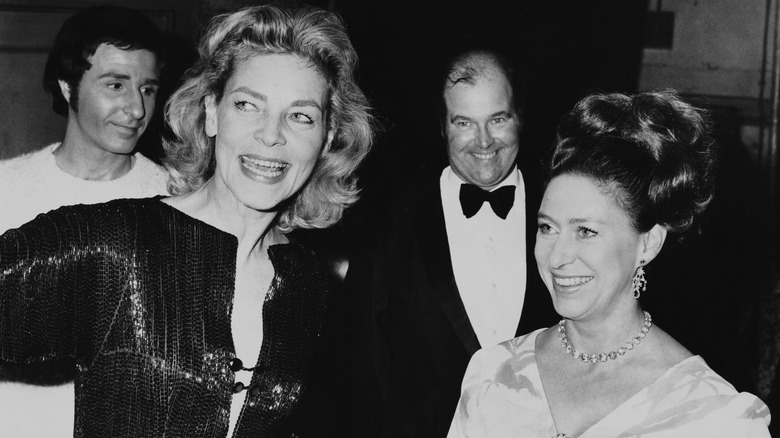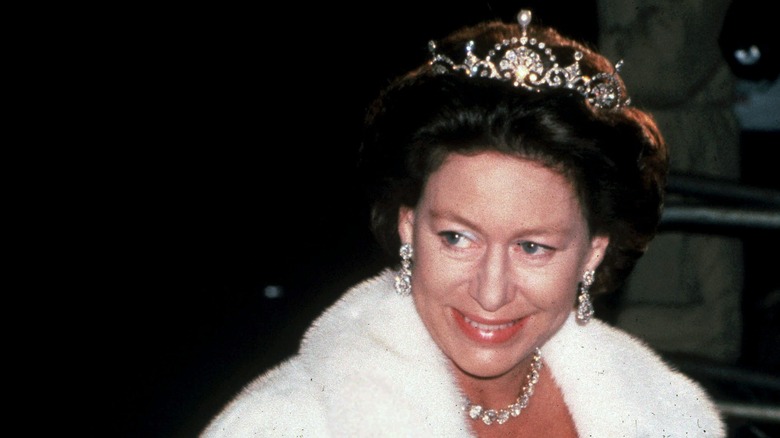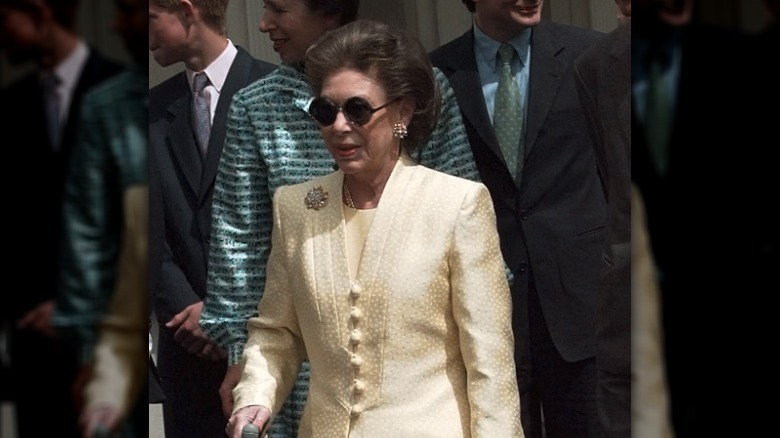A Look Back At Princess Margaret's Life Through The Years
When considering all the members of the royal family that we've come to know and love over the years, Princess Margaret isn't always on the list. Queen Elizabeth's younger sister Margaret sadly passed away in 2002, and as such, isn't frequently talked about in the day-to-day comings and goings of the royal family; this, in our opinion, should change. Margaret was, by all accounts, a trailblazer in her own right, navigating royal life on her terms and living life the way she wanted to.
Becoming the second heir to the throne following her sister after the abdication of King Edward VIII, Margaret occupied that "spare" position for some time. Similar to the spare we've all come to know, Prince Harry, Margaret decided to define the role as she saw fit. Often seen partying with rock stars, lighting up cigarette after cigarette, and living life in the fast lane, Margaret certainly wasn't your typical royal and appeared to revel in her status as the outcast of the family.
Margaret broke a 300-year-old royal tradition
Not many of us can be called a rule breaker from day one, but Princess Margaret broke a royal tradition that had lasted for three centuries. As noted by Britannica, Margaret was born to King George VI and Queen Elizabeth, The Queen Mother on August 21, 1930, the youngest of their two daughters. Given the full title of Princess Margaret Rose Windsor, Countess of Snowdon, the little princess was a welcome addition to the family and broke royal custom as soon as she entered the world.
Margaret was born to her parents at Glamis Castle in Scotland, the place of her mother's heritage. While this may not seem like a big deal, Margaret was the first member of the royal family to be born in Scotland in more than 300 years up until that point (via Britannica), ushering in a new era of royal rule-breaking (something that Margaret embodied for her entire life). From then on, Margaret became a bit of a maverick and displayed an early interest in the arts and music. Educated by both her mother and a governess, Margaret's early life was full of riches and intellect, nothing less for a young princess. Of course, everything changed when King Edward VIII abdicated the throne in 1936, making her — at just 6 years old — the second heir to the crown following her oldest sister.
Margaret displayed differences from her older sister from an early age
It's often difficult to cast yourself as a different character than your older sibling, but Princess Margaret didn't seem to have any trouble in that regard. Radiating herself as a fiery presence from the time she was a kid, Margaret made it clear that she would live life to the fullest at every opportunity she got, and it was something her father King George VI picked up on. Famously saying, "Lilibet is my pride. Margaret is my joy," the king clearly understood that his daughters were different sides of the same coin — harmonious in some capacity, completely different in others (via Vogue).
"Elizabeth was organized, Margaret artistic; Elizabeth discreet, Margaret attention-seeking; Elizabeth dutiful, Margaret disobedient; Elizabeth disciplined, Margaret wild," wrote Craig Brown in "Ninety-Nine Glimpses of Princess Margaret" (via Vogue), contrasting the two sisters at every turn. Still, Queen Elizabeth and Margaret's differences didn't stop their parents from trying to unite the siblings in more ways than one. Royal author Bethan Holt pointed out a small tactic The Queen Mother employed to unite the sisters and stop tension between them before it began — she dressed them in the same clothes. "The Queen Mother had a little bit of a trick to keep Princess Elizabeth and Princess Margaret close growing up and to, sort of, eliminate that sibling rivalry or heir to the spare to the heir mentality," Holt pointed out (via Express).
Elizabeth and Margaret were dedicated to the crown from childhood onward
Though they were just 10 and 6 years old when their father ascended the throne, then-Princess Elizabeth and Princess Margaret were dedicated to the crown and their father's time as a monarch from an early age. Not only did their father take over the monarchy in the wake of his brother's abdication, but he was shortly met with one of the world's most horrific events — World War II. Great Britain, and London specifically, fell under attack throughout the war, and children in the country were evacuated to the countryside (or to different countries entirely) to escape violence. It was a terrifying time for everyone involved, and Elizabeth and Margaret did what they could to show the country a united front and offer a sense of comfort.
As noted by the BBC, Elizabeth was just 14 and Margaret was 10 at the time when they took to the airwaves to wish the children of Great Britain peace and prosperity as they evacuated to Canada, the Americas, and beyond. The radio broadcast was the first time that the future queen and her sister spoke to the Commonwealth citizens and still stands as the earliest recorded message from the queen's lifetime.
Margaret garnered a reputation as a party girl in her youth
Princess Margaret loved a good party. Though she was a princess, she didn't let her aristocratic label stop her from having a good time. As she developed into her youth and teenage hood, Margaret quickly painted herself with a different brush than that of her sister and became a bit of an icon. Christopher Warwick, who wrote "Princess Margaret: A Life of Contrasts," sat down with The Cut to discuss the princess and her party girl era, noting that her habit of "hanging out with the likes of Mick Jagger was simply second nature."
"Smoking at that time was not at all unusual; what was surprising was when she was photographed in a nightclub when she was 19, lighting a cigarette in a long, black cigarette holder," Warwick reflected. "There are things that we do that you don't expect royalty to do, and doing this was pretty cool and trendy and shocking at the same time, but she was perceived as being a very glamorous trendsetter."
Commenting that she was a "very modern person," Warwick noted that Margaret was only one of two women that the press paid attention to amid the 1950s — the other was Elizabeth Taylor. "This is a lady who was modern royalty in a way that Britain hadn't really seen before. To know Mick Jagger was no big deal. To know Peter Sellers was no big deal," Warwick concluded.
The princess had a ridiculous morning routine as an adult
Embracing the high life as a teenager and young adult, Princess Margaret certainly indulged throughout her lifetime. Though we knew Queen Elizabeth as a bit frugal, always put together, and never flaunting her wealth, Margaret was the exact opposite. As the "spare" in her sibling pack, Margaret knew that working as a serious royal was never going to be a part of her life so she lived frivolously, and her morning routine as an adult makes that clear.
As detailed by Vogue, Margaret's mornings would typically start around 9 a.m. and she would be served breakfast in bed. Her meal would be "followed by two hours in bed listening to the radio, reading the newspapers (which she invariably left scattered over the floor), and chain-smoking." By 12:30 p.m., she'd indulge in a "vodka pick-me-up."
By the evening, Margaret would join whichever guests were lucky enough to score an invite for dinner. But said guests couldn't start eating until Margaret was at the table, per royal protocol — a bit of an issue, given that she was notoriously late. Detailed by Nancy Mitford in "Love From Nancy: The Letters of Nancy Mitford" (via Vogue), Margaret didn't even start getting ready until dinner was supposed to start."Dinner was at 8:30 and at 8:30 Princess Margaret's hairdresser arrived, so we waited for hours while he concocted a ghastly coiffure," Mitford detailed at the time.
Margaret and Peter Townsend's love lasted a lifetime
Perhaps one of the most defining aspects of Princess Margaret's life came in the form of her affair with Group Captain Peter Townsend. Any fan of "The Crown" knows that their love story was mired with pain, sadness, and the inability to actually be together; to this day, it remains one of the most tragic aspects of Margaret's life.
As noted by Harper's Bazaar, Margaret and Peter — a pilot in the Royal Air Force and an equerry for the king — met in 1947. Not only was he 15 years older than the princess, but he was in the process of divorcing his then-wife. Anyone who watches the royal family knows that divorce was, and still is, to an extent, a huge red flag. Divorce is extremely tricky for royals — and was even more so back in the 1940s — making Margaret and Townsend's love affair nearly impossible. To make matters even more complex, Margaret was not even 25 years old, meaning that her older sister had to approve of whoever she married.
Eventually, the couple painfully went their separate ways, with Margaret stating at the time that she could not go through with their romance given her royal status. But, as Townsend released in his 1978 autobiography, he and Margaret could've had a life together if "she had been prepared to give up everything — her position, her prestige, her privy purse."
Margaret struggled with both loyalty and jealousy when it came to the queen
As Princess Margaret and Queen Elizabeth grew into their respective roles within the royal family, their differences became even more apparent; Elizabeth was the dedicated monarch who did everything by the book, and Margaret was the rebel who lived life largely on her own terms. As such, there grew both loyalty and tension between the sisters, with famed royal biographer Andrew Morton telling Vogue that Margaret's role as the "backup" only went so far. "There's an awful lot of jealousy because Margaret was the one who commanded attention and she loved the spotlight. It's a complex relationship; it's one of loyalty and support, but also primal jealousy," Morton attested.
"On one occasion Margaret slams into the queen's drawing room at Windsor Castle whilst the Prime Minister was there; she walks in and, in addressing her, says, 'If you weren't Queen, nobody would talk to you.' That is to say she wasn't that interesting. You see this jealousy and you also see this loyalty that Margaret had towards Elizabeth," Morton said (via Vogue).
Further commenting on the dynamic between the sisters, Anne Glenconner, who served as Margaret's lady-in-waiting, opened up about the element that Margaret was keenly envious of: Elizabeth's education. "She always minded about not being educated as well as the queen," Glenconner told People. "The queen had people from Eton and Cambridge, naturally. But Princess Margaret was never part of that."
Margaret got married in 1960
Though Queen Elizabeth and Prince Philip got married before she ascended the throne, Princess Margaret's love life was a far more sordid and interesting component of royal life that the public could sink their teeth into. After her love affair with Peter Townsend came to an end, Margaret moved on and eventually married Antony Armstrong-Jones in 1960. The couple had their fair share of problems but despite this, their reputation in the glittering circles of high society was unmatched.
"During the 60s, before their marriage started going wrong, they were royalty's golden couple," Margaret's biographer Christopher Warwick told People of the famed marriage. "Stories about them were legion, with their star-studded parties at Kensington Palace. If you were being invited by them you were being invited to breathe in rarified air."
Making the couple that much more interesting, Vogue pointed out, the two had a bit of a game that they played with one another at palace dinner parties. Dubbed the "bread game," Margaret and Armstrong-Jones would listen in on conversations and tear off a small piece of bread whenever someone uttered a "cliché" phrase, placing the piece of bread on the table. Whichever between them had the most bread at the end of the meal would win — we're not sure if this is rude or iconic, or perhaps both.
The princess' divorce was a dark time for her, according to this close source
Eventually, Princess Margaret's marriage to Antony Armstrong-Jones went south. As the relationship reached a breaking point, going their legal separate ways was the only option. As noted by History, it was 1976 when photos of Margaret and her rumored "toy boy" Roddy Llewellyn hit the papers. Not only was she a married princess, but he was 17 years younger than her, and the dynamic created quite a field day. But, as her lady-in-waiting Anne Glenconner detailed for Hello!, the princess was at a breaking point in her marriage and though she saw divorce as a horrible path to walk, it was the solution she was looking for. "She hated the idea of divorce, and resisted for a long time, but I watched as Tony placed her in an impossible position, demeaning her and goading her into making it inevitable," Glenconner said.
When the divorce was finally upon her, Armstrong-Jones sent Margaret's secretary Lord Napier in with the news — if that's not the most brutal thing we've heard. When Napier told Margaret that Armstrong-Jones was leaving her, Margaret said in response, "Thank you, Nigel. I think that's the best news you've ever given me" (via History).
Margaret had several peculiarities that solidified her quick-witted status
If we've presented anything, it's that Princess Margaret was a royal trailblazer in more ways than one. She partied, got divorced, was fraught with dedication and jealousy, and marched to the beat of her own drum despite what anyone else thought. With all this in mind, it doesn't come as a huge shock that she had a number of peculiarities that she came to be known for — we weren't banking on learning that Margaret hated a particular woodland creature or tried to invent a contraption that would let her indulge in more ways than one, but alas, here we are.
As noted by Vogue, Margaret was first and foremost known for her checkbook. When writing a check out to someone, she wouldn't sign the money order with anything other than "Margaret." Not her last name, not her royal title, nothing — simply, "Margaret." It is, when you think about it, a bit iconic. As for the woodland creatures ... Margaret made her hatred of squirrels clear, and once attacked a group of them with an umbrella after she saw a lady handing them morsels of food in a park. We promise we're not kidding. To top off the list, Margaret once tried to create a contraption by "gluing matchboxes onto tumblers" so she could light a cigarette while drinking at the same time — her two favorite habits. And we thought the latest batch of royals were dramatic.
The princess and the word 'budget' did not get along
When we think about the royals, we often envision opulence at just about every turn. Castles, tiaras, state events, gorgeous gowns — you name it, they seem to have it, and Princess Margaret was the embodiment of this. As noted by Vogue, Margaret once famously said, "Disobedience is my joy," and that perspective certainly applied itself to her budget ... or lack thereof. The princess embraced just about every perk and luxury of royal life. Instead of driving herself as many royals do, Margaret traveled by chauffeured limousine — even Queen Elizabeth was spotted behind the wheel on occasion. She'd often request that her vehicle be escorted by motorcycles, and she was even known to charter a helicopter to fly her a mere 13 miles down the road. She'd also shop in Harrods and Marks & Spencer and pay with cash or with her famous "Margaret" signed checks.
Like clockwork, Margaret got her hair done every Friday, and her clothing budget knew no bounds (via Vogue). When it came to travel, the princess didn't spare any expense. Her honeymoon alone cost $115,000 in 1960 which is about $1.1 million in 2022, given the 88% inflation rate in the years gone by. To top it off, she required people to call her "ma'am," and to friends, she was "ma'am darling."
Margaret passed in 2002 at the age of 71
Princess Margaret was an iconic royal in her own right, and her specific way of living was just as amusing as it was quite tragic. She knew heartbreak intimately, she was never allowed to marry the man she truly loved, and she suffered extreme health issues toward the end of her life. Sadly, on February 9, 2002, Princess Margaret suffered her third stroke and died shortly after at King Edward VII's Hospital in London (via Today). Known for her heavy drinking and smoking, Margaret's death was quickly tied to her bad habits, but her friends defended her honor in the wake of her death. "Of course, the princess grew up in an age where drinking and smoking was much more acceptable," a friend said at the time (via Today). "We all did. However, I don't believe she was addicted to alcohol. It's preposterous. She just got very used to it."
In addition to her partying ways, Margaret underwent surgery in 1985 to remove a part of her left lung — eerily reminiscent of her father's own procedure years prior. In 1999, her health was once again in the headlines when she burned her feet in a hot bath of water, hindering her mobility. Her sister Queen Elizabeth was visibly shaken by the death of her younger sister and would go on to live another 20 years without the person who had been there for her through thick and thin.
